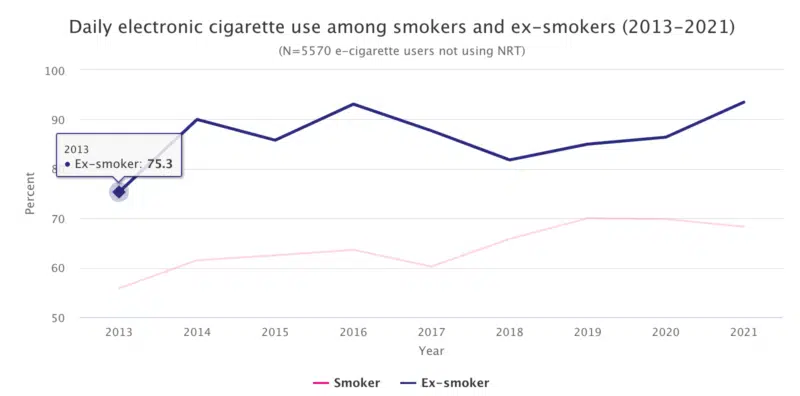Industry Research
UK Vape Trends
Quarterly studies analysing electronic cigarette trends in England are conducted by researchers at University College London.
UK Vape Trends; Professors Loren Kock, Robert West, Emma Beard, Dimitra Kale, and Jamie Brown at University College London’s Institute of Epidemiology & Health Care produce a quarterly review of electronic cigarette use in England. The ongoing study keeps track of how vaping is replacing smoking and what work needs to be done by politicians to maximise the benefits of e-cigs.
Electronic cigarettes first started being used in England in 2008. Over the next couple of years, we saw the number of vapers increase from a handful to hundreds of people. By 2011, word of mouth had inspired the number of people successfully switching away from smoking to vaping to increase to tens of thousands. The following three years saw vaping as a phenomenon explode; internet forums multiplied, sharing information, and the number of users in England leapt from hundreds of thousands to millions.
The graph that plots the use of vape devices and the number of smokers demonstrates a stark correlation. Even before research studies were being conducted, it was clear that electronic cigarettes were displacing tobacco products from the market.

New Evidence for the Relative Safety of Vaping
Since then, studies have confirmed what we were seeing. In no small part, this was because science confirmed vaping was far safer than smoking. University College London’s Sarah Jackson, Emma Beard, and Jamie Brown wrote in 2021: “Consensus across England’s public health community that e-cigarettes are substantially safer than smoked tobacco, a lack of evidence of harm to bystanders from exposure to e-cigarette vapour, and guidance issued by Public Health England that encourages evidence-based policies that distinguish between smoking and vaping.”
Devices and e-liquids were then regulated by parliament as consumer products, ensuring safety, quality, and reliability. England now leads the world in its approach to vaping and is home to many vape shops that can offer professional advice to smokers looking to switch.
Why Is This Monitoring Needed?
Firstly, England has a target of achieving a smoke-free country by 2030. Now that vaping is fully accepted to be a key method of helping smokers quit tobacco use, University College London’s key indicator monitoring informs tobacco control action.
Last year, in their trend study, University College London researchers identified that there was a growing issue with the number of vapers declining and the number of smokers quitting tailing off.
They recognised the problem was being caused by the wealth of misinformation and lies being carried in news stories and from dubious studies in the United States. With the problem identified, they encouraged politicians to address the matter – and their recommendations have been taken on board by the team currently crafting the next Act to be announced in parliament soon.
What Does the Current Review Show?
The latest University College London study showing e-cig trends in England delivers positive news. The decline in the number of people vaping has been arrested and gone back up to its previous high point.
The team note that vaping is now the number one choice for smokers trying to quit tobacco use. Plus, while this is happening, the use of e-cigs by people who have never smoked remains at very low levels. They say that vaping is working to prevent ex-smokers from relapsing back to cigarette use.
An interesting point they have drawn from the data is the growth of interest in 20mg/ml strength e-liquids and the use of higher strength (albeit illegal) juices.
The full findings on vaping trends in England can be read here on smoking in england website.
